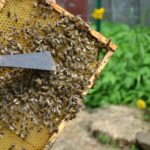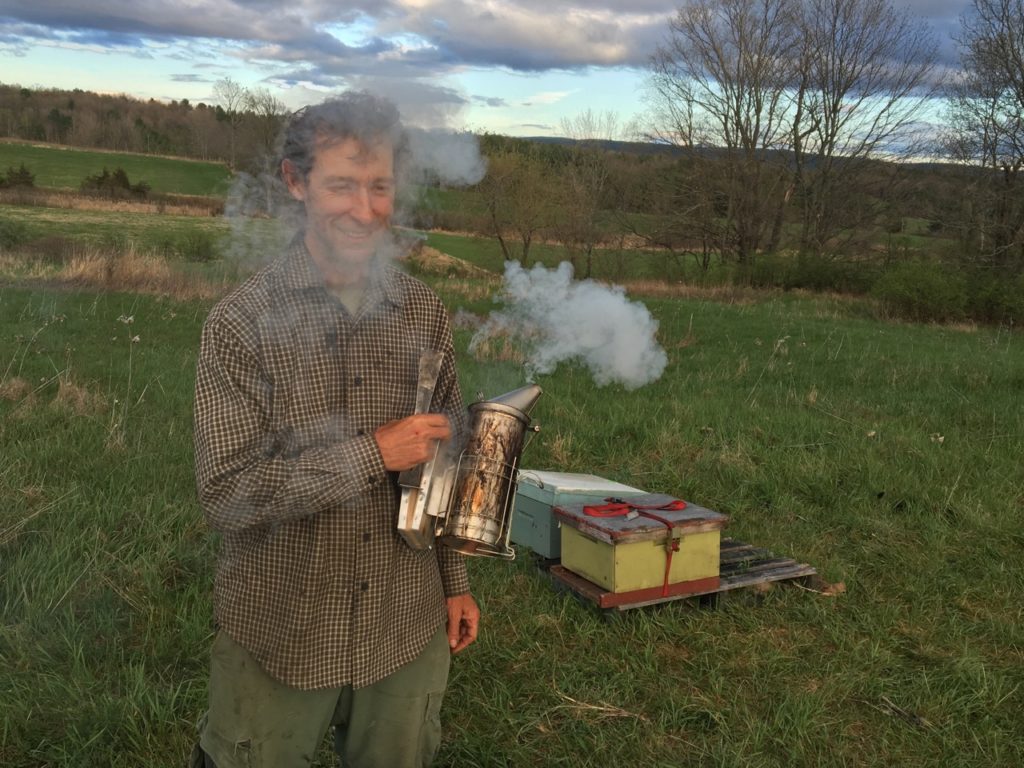Honey bees on the farm will pollinate our flowers. Todd began a relationship with honey bees over 50 years when he and his brother Tom, 9 years old, bought their first hive for their family farm. They were enchanted by how industrious the bees were, giving them honey, pollen, propolis and beeswax for candles and salve. Around 40% of what is eaten is pollinated by insects, this to a great degree by honey bees. Because there are so few nectar & pollen plants on Thornhill Farm, we are planting these plants for the bees. We know the soil is worn out on the farm because our honey bees make so little honey. This is why we have pigs. When the forest is cleared, we do not burn the wood that is left behind, but chip it and mix these wood chips with manure and fungus mycelium to make piles of compost to improve the soil. Last summer we grew peas and oats as a green manure crop, and the pea flowers gave voluminous amounts of nectar to the honey bees and pollinating insects.
Health & the Hive: A Beekeeper’s Journey
 A Jan Cannon Film that explores the importance of honeybees in our lives through the seasons of Honey Gardens Apiaries, Todd and the team. Topics addressed in the film include pollination, queen breeding, disease control, bee venom therapy, organic agriculture and honey-based plant medicine. 53 minute dvd. $10 + $4 (shipping).
A Jan Cannon Film that explores the importance of honeybees in our lives through the seasons of Honey Gardens Apiaries, Todd and the team. Topics addressed in the film include pollination, queen breeding, disease control, bee venom therapy, organic agriculture and honey-based plant medicine. 53 minute dvd. $10 + $4 (shipping).
to order, send a check to: 198 Taylor Road, Greensboro Bend, Vermont 05842
writings & images about the honey bees of Thornhill Farm
- Tim McFarline, McFarline Apiaries, Benson, Vermont June 3, 2016

Tim McFarline, McFarline Apiaries, Benson, Vermont. Tim raises queen bees organically from survivors and sells colonies of bees each Spring. We worked together for six years. May 2016.
Live from the Hive by Annie Watson – Winter 1997 to July 2015 archives
- Live from the Hive: November 2013“Chicory and Thanksgiving” by Annie Watson We had long warm fall, which allowed the bees to forage late into October. On many days the temperature got well above 60 degrees, allowing the bees to fly, and, we hope, make more honey to prepare for the winter. During the warm fall the lasting blooms of the chicory flower ...
- Live from the Hive: October 2013“New England Aster” By Annie Watson This is a great year for our native purple New England Aster (Aster novae-angliae) . These perennial flowers provide beautiful fall color in our meadows, hedgerows and roadsides, and food for many creatures including bees and other insects, wild turkeys, deer, and rabbits. The flower petals can be purple, lavender, ...
- Live from the Hive: September 2013“Late Summer Abundance” By Annie Watson The sunflower is such a symbol of the richness of late summer. The bees have pollinated them; their seeds are gradually maturing. Beekeepers have been harvesting honey since mid-August, elderberries have ripened and been picked. This month the honeybees will bring in goldenrod pollen, working overtime to make enough honey ...
- Live from the Hive: August 2013“The Height of Summer” By Annie Watson Yesterday we walked the Champlain Valley, surrounded by the richness of the peak of summer. The honeybees foraged in the hot sun on burdock, white sweet clover, purple globe thistle, chicory, white clover, black cohosh, motherwort, and more; the hummingbird moths and swallowtail butterflies sipped from bee balm, and ...
- Live from the Hive: July 2013“Swarming Season” By Annie Watson There is nothing so thrilling as lying in the grass on a hot May or June day while thousands of bees fly in a circular pattern overhead, the air filled with the sound of their wings. Drawn by the queen’s pheromone, the swarm comes to temporary rest in a large clump ...